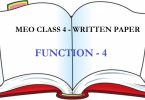|
1 |
Standing order and other special instructions of the Master, relating to navigation of the ship |
| 2 | Compare Passage Plan / Master’s Orders |
| 3 | Position, Charted Course, Course Steered, Course Made good, speed of the ship. |
| 4 | Check draft, depth available, squat and UKC. Echo Sounder ON as required |
| 5 | Check and compare method(s) of position fixing |
| 6 | Conspicuous position fixing targets (Visual Radar) |
| 7 | Status Radar / ARPA sets |
| 8 | GPS position comparison , Datum corrections |
| 9 | Check ECDIS, position, route ,chart display ( If Fitted) |
| 10 | Forthcoming alterations, DTG, ETA and current speed |
| 11 | Prevailing and predicted tides, currents, weather and visibility and effect of these on the course and speed |
| 12 | Navigation situation including but not limited to a. Traffic density. b. Vessel’s position relative to navigational hazards |
| 13 | Procedures for the use of Main Engine to manoeuvre , when the Main Engine is on bridge control and status of watch keeping arrangements in the engine room . (Main Engine RPM / Pitch, Duty Engineer) |
| 14 | Lookout available |
| 15 | Off Course Alarm ON |
| 16 | Gyro Compass / Magnetic Compass comparison and Gyro Error |
| 17 | Auto Pilot status / or Anchor details if at anchor |
| 18 | Check Course Recorder and VDR/SVDR operation (if Fitted) |
| 19 | Latest navigational warning(s)/Weather /Visibility , Navtex status |
| 20 | Check status of AIS and specific voyage & dynamic information |
| 21 | Navigation lights / shapes correctly displayed |
| 22 | GMDSS / VHF set up correctly on correct channels/ power level |
| 23 | Status of Fire Detection / Gas Detection |
| 24 | Inert Gas Pressure / O2 content (for Tankers) |
| 25 | Other: any special deck work in progress – Tank/Hold Cleaning, Enclosed Space tank entry, drills, etc. |
| 26 | Log book Entries |
| 27 | Ship Security Status (Level / Requirements) |
Initials of Officer to be Relieved |
|
Initials of Relieving Officer |
|
|
|



